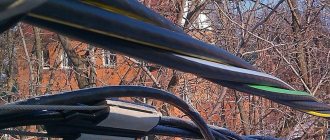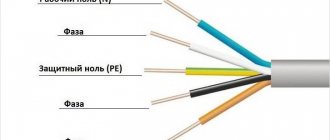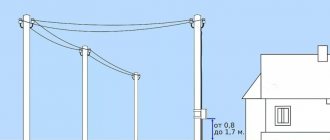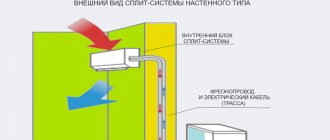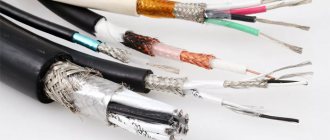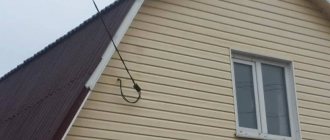By using a cable for laying in the ground, you choose a reliable installation method. After all, the cable underground is protected from external influences (wind, frost, etc.), and also does not spoil the aesthetic appearance. However, laying cables in the ground is a rather labor-intensive process that requires compliance with the rules of PUE and PTEEP.
To lay a power cable in the ground, you need to carefully select the brand of cable. As a rule, the cable brand is selected based on the type of soil and its corrosiveness and the operating conditions of the cable. Corrosive activity depends on many factors, for example, the wetter and more acidic the soil, the higher the indicator. Here are some examples of ground cable brands and features for their installation. Operating conditions mean whether tensile loads will be applied to the cable. As a rule, I use armored cables for laying in the ground, since they do not require the use of additional protection during installation.
What cables can be laid underground?
In the trench, the cable is protected from temperature changes, solar radiation, rain moisture, strong wind, and icing. But there are some striking factors here:
- ground movements;
- rodents;
- the likelihood of damage during excavation work.
It follows that the conductor must have increased mechanical strength.
Therefore, for laying in the ground they use:
- armored cables that have metal tape or wire in their design;
- simple AVVG and VVG in a pipe or corrugation.
The first option is considered preferable.
SNiP 3.05.06-86 and GOST 16442-80 allow the laying of simple VVG or AVVG without protection if:
- soil corrosivity is low or moderate;
- no tensile load;
- the section is laid horizontally;
- the soil is not swampy, unfilled and not heaving.
SIP wire cannot be used for underground installation, even in a pipe.
Its insulation quickly deteriorates due to frequent condensation.
Cable Specifications
Explorer properties describe the following parameters:
- core material – aluminum or copper;
- their number and section;
- their type - monolithic or stranded;
- material and flammability class of insulation and shell;
- Rated voltage;
- maximum permissible long-term heating temperature;
- the same in short-term mode (during a short circuit);
- minimum bend radius;
- tensile strength;
- cost per linear meter;
- design: presence of armor, waterproofing, number of layers in the shell, etc.
Labeling with explanation
The main characteristics of the cable are usually designated by an alphanumeric code. For example, the following can be said about the product brand AVVGng-ls 3x16:
- A – aluminum cores. If this letter is not present at the beginning, it means the cable is copper (VVG).
- VV - core insulation and sheath are made of vinyl or PVC. Other options are polyethylene (P), self-extinguishing polyethylene (Ps) and paper impregnated with oil rosin (C in front of the designation).
- G – “naked”. This means that there is no special protection.
- ng – non-combustible insulation. The material is assumed to be non-flammable.
- hp – low smoke emission (from the English low smoke).
- 3x16 – 3 cores with a cross section of 16 sq. mm.
The presence of armor is indicated by the letters:
- B – from tape;
- K – from round steel wire (Ka – aluminum);
- P - from flat.
Shell type:
- Shv – vinyl hose;
- Shp - the same from polyethylene.
A small “b” means the presence of a bitumen layer, “l” means a layer of plastic tapes under the armor.
For example, VBBShV cable is often used for underground installation. It has copper conductors (the letter “A” is missing), PVC insulation (B), tape armor (B) and a bitumen layer (b), and a vinyl hose (Shv) on the outside.
The combination “AA” denotes aluminum conductors in the same sheath, “AC” – lead conductors.
Types of pipes used
In previous years, underground installation was carried out using steel and asbestos cement pipes. Now they have added products made from different types of plastic:
- polyvinyl chloride;
- polypropylene;
- high pressure polyethylene;
- low density polyethylene.
The use of each type is regulated by regulatory documents - GOST and SNiP. For example, only a control cable is allowed to be laid underground in a steel casing, since the power cable with such installation has no protection in the event of a breakdown.
Steel pipes today are used for wiring inside buildings Source wirings-diagram.com
Asbestos-cement pipes are almost never used these days due to their fragility and heavy weight; the use of steel pipes, which are quite expensive and subject to corrosion in a humid environment, is also limited. They were replaced by plastic, the material is lightweight, durable, non-corrosive, and has excellent dielectric properties. Plastic pipes can have different cross-sections, wall thicknesses, be smooth or corrugated, single- or double-layer.
Features of armored cables for underground installation
This cable includes the following elements:
- Conducting conductors. Conducts electricity from source to consumer.
- Their isolation. Eliminates contact of cores with each other, which would lead to a short circuit.
- Cable filler. Serves as a sealed package for the conductors, gives the conductor its shape and makes it durable.
- Waist insulation. Combines current-carrying conductors into a monolithic structure. Also serves as additional insulation.
- Protective shell. Protects the cores from the effects of environmental factors, gives the cable strength and rigidity.
- Pillow shell. Protects the previous element from damage by the subsequent layer.
- Steel armor. Protects the product from damage.
- Outer cover. Protects the previous layer from environmental chemical aggression.
Video description
Confirmation of how durable a corrugated pipe is is this video:
Installation features
The electrical HDPE pipe for cables in the ground has design features that distinguish it from general purpose pipes.
- For a quick, reliable and tight connection, they are equipped with special couplings without sockets.
- To pull the cable through the pipe, the products are equipped with special probes in the form of steel wire.
Couplings for joining pipe sections Source elnow.ru
Requirements for underground cable laying
The rules for installing a power line in a trench are set out in clause 2.3.83 of the PUE and subsequent ones, as well as in SNiP 3.05.06-86. For cables with voltages up to 20 kV, which include household cables at 220V, 380V and industrial cables at 10 kV, the minimum depth is:
- under an area not subject to loads (lawns, etc.) – 0.7 m;
- under the road, paved area, sidewalk - 1 m.
For entry into the house, it is allowed to reduce this parameter to 0.5 m, but only on a plot of no more than 5 (m) in length.
If several cables need to be laid in a trench, the minimum distance between them is 10 cm.
The shortest distance between the route and various objects on the site (m):
- foundation – 0.6;
- power or communication line of a third party – 0.5;
- tree – 2;
- bush – 0.75;
- pipeline, sewerage – 1;
- heat pipeline, for example DHW – 2;
- gas pipeline with pressure up to 0.588 MPa - 1, above 0.588 MPa - 2.
When laid along a building, the cable should be behind an imaginary line drawn from the edge of the foundation base downward at an angle of 45°.
It is prohibited to lay conductor above and below cable routes and pipelines. They can only be crossed, and both lines must be separated by a layer of earth at least 0.5 m thick.
Briefly about the main thing
Underground cable laying eliminates accidental breakage and electric shock to people. Despite the need to perform excavation work, this method is considered more preferable, since there is usually no need to maintain or repair the wires.
Before laying a wire underground at the dacha, you should draw up a working drawing where the route will be marked in compliance with all permissible distances and gaps
In addition, it is important to maintain the specified trench depth and avoid sharp turns
Only suitable grades of conductor should be used and the correct cross-section should be ensured. Power should be calculated with a margin, since the load may increase.
Instructions for laying cables underground
The initial stage involves the following actions:
- The administration of the locality receives a site plan with existing underground utilities.
- Based on the drawing, they develop their own scheme for laying the line, linking it to stationary objects.
- Using pegs and twine, markings are made on the site.
Digging a trench
The width of the trench is selected taking into account the following regulatory requirements:
- the distance between cables is 10 cm;
- the sand cushion extends 10 cm beyond the outer conductor.
The depth of the trench is 200 mm more than the normal line level, i.e.:
- on the lawn - 0.9 m;
- under the road – 1.2 m.
Having dug a trench to the required depth, proceed in this order:
- Clear the bottom of large rhizomes, stones, glass and other debris. All this can damage the cable.
- A layer of sand 20 cm thick is poured. It prevents damage to the shell and, due to its drainage properties, removes moisture.
- They compact the sand, moistening it abundantly with water (it is better to do this in layers) so that its thickness is 15 cm. Without this, the bedding will sag and voids will form under some sections of the cable, which will lead to its local overheating. Uneven temperature distribution will lead to deformation of the product with subsequent damage to the insulation.
- Lay the conductor on the sand along a wave-like path. This ensures the required length margin of 2%, which prevents rupture of the product due to ground movements.
- A control measurement of the insulation resistance between the cores and the shell is carried out. For this you need a megohmmeter.
- A layer of sand 20 cm thick is poured on top. It is also moistened and compacted so that the height of the pillow is 15 cm.
- Pour 15 cm of soil. They also ram it.
- Place orange plastic warning tape with the inscription “Caution, cable!” If there are several conductors in the trench, use 2 or 3 warning plastics so that they extend beyond the outer lines by 5 cm.
- They dig a trench. To compensate for future shrinkage, the soil is poured with a small margin.
- Check the insulation resistance again with a megohmmeter. The probes of the device are connected to the conductors in pairs, then in turn to each of them and to the shell.
Safety precautions
When installing the cable, observe the following rules:
- The cable drum is unloaded using lifting equipment.
- When rolling it, measures are taken to prevent the protruding parts from catching the fitters’ clothes.
- The drum is moved only on a horizontal surface; it is prohibited to stand in its path.
- When rolling, the reels do not approach the trench closer than 1 m.
- The cable is unwound using canvas gloves.
- The conductor is carried on the shoulder facing the direction of the trench; all workers should be on one side of him.
- The maximum permissible load per worker is 35 kg.
- If, when digging a trench, they come across communications that are not indicated on the plan, the work is suspended and they begin to search for the owner or operating organization.
In places where the route turns, it is prohibited to stand inside the corner, support the cable or pull it by hand. Special rollers are installed here.
Only a certified installer has the right to test cable insulation using a megohmmeter. This is due to the fact that during operation this device generates voltage up to 2500 V. After checking, you need to discharge the cable to the ground or short-circuit its wires.
Electrical cable for the street - choose a stranded wire
To connect home equipment, you must join existing power networks. This requires a cable that can be installed outdoors. The operating features of such cables require special characteristics from them: resistance to combustion, strength, lack of hygroscopicity.
Types of street conductors
There are several types of such cables, the most used of them are:
- SIP is a power street type that can withstand a potential difference at the ends of the conductor of 1000 V. It is a combination of wires that have their own insulation and aluminum conductors. A special feature is the black sheath of the conductors. This outdoor cable is compact and reliable. Installed by air using porcelain insulators and guy wires.
- AVB6Shv - a combination of conductors with armored insulation. Copper or aluminum cores depending on the type of cable. It is laid in the ground without the use of additional protection. Characterized by:
- the presence of steel tape in the shell;
- multi-colored insulation for correct connection and checking circuit integrity;
- resistance to humidity, temperature changes;
- service life of 30 years.
- NYY is versatile. Has copper or aluminum conductors. Manufactured in accordance with international standards. Different when used:
- resistance to water, fire;
- different colors of wire insulation;
- outer PVC plastic shell;
- resistance to sudden changes in the environment.
- NYM, the most commonly used outdoor cable. The quality meets the standards of German electrical engineers. Possesses:
- heat resistance, heat resistance;
- lack of hygroscopicity, allowing installation in concrete under a layer of plaster.
Installation of wiring on the outside of a residential building
The use of cables for outdoor installation requires compliance with certain rules. The distance to the porch should not be less than two and a half meters, windows, balconies - 100, 50 centimeters. The vertical version requires a length from the ground surface of 2.75 meters. When laying wiring along the wall, the following conditions must be observed:
- separately mounted wires are protected by metal and plastic pipes;
- The use of twists is prohibited. Connection using terminal blocks;
- The cable is suspended by securing it with a corrugated sleeve using a cable;
- the wires are connected in sealed junction boxes;
- installation on the roof is prohibited.
Other cables for outdoor wiring
The home electronics used require external connection of special wires insulated with sheaths.
Internet cable for the street is mounted on walls, roofs, cable ducts without contact with power lines. You can use different types of twisted pairs with different insulating coatings (UTP, FTP, SFTP, STP, SSTP). When laying data lines, we recommend NVPE, which is not affected by electromagnetic interference, KSVPPE, which is classified as high-voltage products for structured cable systems.
A flexible outdoor cable with rubber insulation allows you to solve various situations associated with sunlight and high loads. Used to connect mobile equipment, lighting devices in an atmosphere of high humidity (KG, KPGT, KTG, KGN, CNG).
High-quality television broadcasting also largely depends on outdoor television cable. This uses:
- coaxial, providing protection from external interference, reducing the loss of the electromagnetic field due to radiation;
- composite. One of the three conductors transmits a video signal, two – stereo pulses. Allows you to connect video devices to a TV, monitor;
- component, transmitting high quality digital impulses for satellite television;
- HDMI, DVI, used when connecting game consoles and other computer equipment.
The service life of wires for external installation largely depends on the switch mounted externally. The most functional of electrical installation products is considered to be moisture-proof single-pole. It is used for both hidden and open installations, connected through a sealed distribution board.
Thus, no matter what the purpose for which the cable is laid outdoors, it is not difficult to find a suitable one; the main thing is to comply with the standards and safety measures during installation and use a type appropriate to the street conditions.




